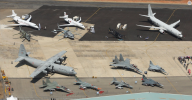One interesting aspect of it is how the IAF’s two Su-30MKIs dueled with eight PAF F-16s during the conflict. The North group of 4 F-16s engaged our Flankers, which fired 3 AIM-120C AMRAAM BVR missiles. All the missiles missed their mark. The Sukhois pushed them back, while also picking up another group of 4 F-16s and multiple inbound strike aircraft from the Southern formation. This in essence meant that the Avengers were heavily outgunned by the PAF formation carrying more advanced American BVR missiles, and in sheer numbers. A fourth AMRAAM was fired by the South Group.
By advanced mapping, it could be deduced that by that time the Su-30MKI jets were just 25-30 kilometers away from the North Group jets. This fourth AMRAAM was also evaded by the Sukhois.
IAF Flankers, instead of retreating, counterattacked in a bold move against the F-16s ignoring the high-density BVR threat from the F-16s, in all probability breaching the AMRAAM MAR to press home the R27/77 attack 25-30 km from lead PAF jets in the North Group.
This meant that the things turned out to be the other way for the PAF, the Su-30s instead of returning dashed on to the F-16s to make them come under the R-27/77 missile range. This is because the Su-30MKIs were not carrying long-range BVR missiles, and had medium-range missiles, whose range problem had to be mitigated by bringing F-16s closer. The lead North Group F-16 fighters, instead of attacking the incoming Sukhoi, went ‘COLD’ prematurely.
That is the reason for the 10 out of 12 Pakistani bombs falling well out of the range of their intended targets was because of this unexpected counterattack by the IAF fighters


 eurasiantimes-com.cdn.ampproject.org
eurasiantimes-com.cdn.ampproject.org

 eurasiantimes-com.cdn.ampproject.org
eurasiantimes-com.cdn.ampproject.org










 we have the liberty and money to play with various stuff and get technical assistance from France, Russia, Israel and in certain circumstances the US.
we have the liberty and money to play with various stuff and get technical assistance from France, Russia, Israel and in certain circumstances the US.

